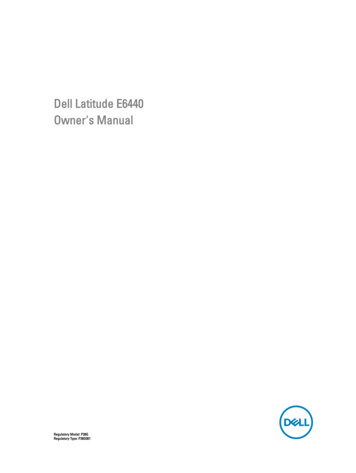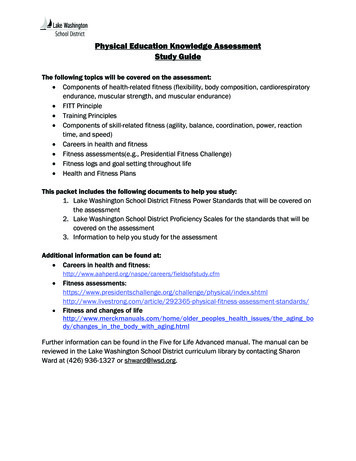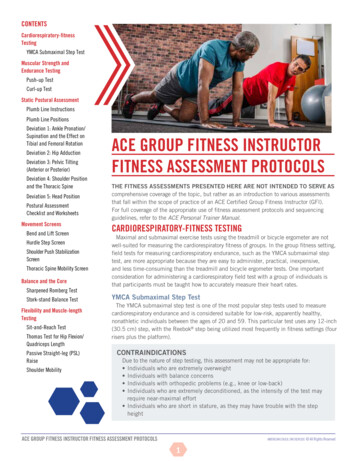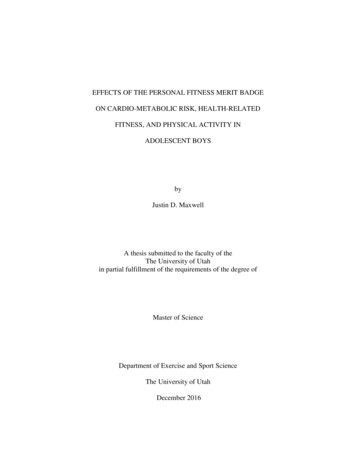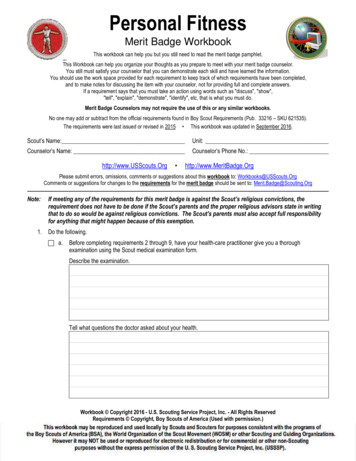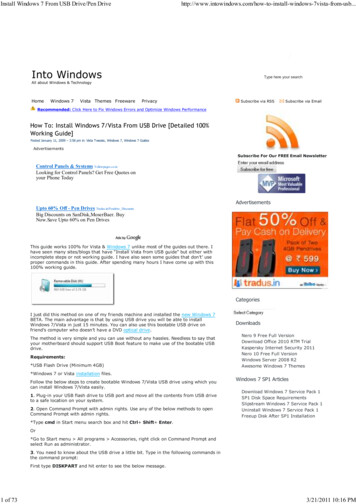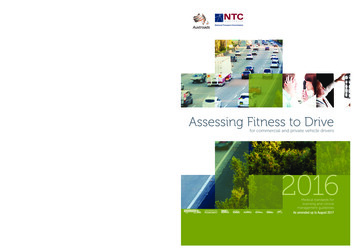
Transcription
Assessing Fitness to Drivefor commercial and private vehicle driversAustroadsLevel 9, 287 Elizabeth StreetSYDNEY NSW 2000 AustraliaPhone: 61 2 8265 3300www.austroads.com.au2016Medical standards forlicensing and clinicalmanagement guidelinesAs amended up to August 2017
Assessing Fitness to Drivefor commercial and private vehicle drivers
Help for professionalsFor guidance in assessing a patient’s fitness to drive contact your State or Territory driver licensingauthority (see Appendix 9 for details). Information is also available from the Austroads website:www.austroads.com.auAssessing Fitness to DriveFirst Published 1998Second Edition 2001Third Edition 2003Reprinted 2006Fourth Edition 2012Reprinted 2013Fifth Edition 2016Reprinted 2017 Austroads Ltd 2017This work is copyright. Apart from any use as permitted under the Copyright Act 1968, no part may be reproduced by any process withoutthe prior written permission of Austroads.National Library of AustraliaCataloguing-in-Publication data:Assessing Fitness to Drive 2016 as amended up to August 2017ISBN: 978-1-925451-95-5Austroads Publication Number: AP-G56-17Design and typesetting: d fa DesignPublished by Austroads LtdLevel 9, Robell House287 Elizabeth StreetSydney NSW 2000 AustraliaPhone: 61 2 8265 3300Fax: 61 2 8265 3399Email: roads believes this publication to be correct at the time of printing and does not accept responsibility for any consequences arisingfrom the use of information herein. Readers should rely on their own skill and judgement to apply information to particular issues.Document History1 September 2016Document first published.1 August 2017Corrections relating to repaired abdominal and thoracic aneurysms to reflect agreed policy (page 51)and visual aids (page 127). Contact details updated in Appendix 9.
Assessing Fitness to Drivefor commercial and private vehicle drivers2016Medical standards for licensing andclinical management guidelinesa resource for health professionals in AustraliaAs amended up to August 2017
AustroadsAustroads is the peak organisation of Australasian road transport and traffic agencies.Austroads’ purpose is to support our member organisations to deliver an improved Australasian road transport network. To succeedin this task, we undertake leading-edge road and transport research which underpins our input to policy development and publishedguidance on the design, construction and management of the road network and its associated infrastructure.Austroads provides a collective approach that delivers value for money, encourages shared knowledge and drives consistency forroad users.Austroads is governed by a Board consisting of senior executive representatives from each of its eleven member organisations: Roads and Maritime Services New South WalesRoads Corporation VictoriaDepartment of Transport and Main Roads QueenslandMain Roads Western AustraliaDepartment of Planning, Transport and Infrastructure South AustraliaDepartment of State Growth TasmaniaDepartment of Transport Northern TerritoryTerritory and Municipal Services Directorate, Australian Capital TerritoryCommonwealth Department of Infrastructure and Regional DevelopmentAustralian Local Government AssociationNew Zealand Transport Agency.National Transport CommissionThe National Transport Commission is an inter-governmental agency charged with improving the productivity, safety and environmentalperformance of Australia’s road, rail and intermodal transport system.As an independent statutory body, the NTC develops and submits reform recommendations for approval to the Transport and InfrastructureCouncil, which comprises federal, state and territory transport, infrastructure and planning ministers.The NTC also plays an important role in implementation planning to ensure reform outcomes are realised on the ground, as well ascoordinating, monitoring, evaluating and maintaining the implementation of approved reforms.NTC’s visionAustralia’s prosperity and community liveability is enhanced by the movement of people and goods.NTC’s missionTo champion and facilitate changes that improve productivity, safety and environmental outcomes.NTC’s roleBy developing national regulatory and operational reform and implementation strategies for road, rail and intermodal transport.ivAssessing Fitness to Drive 2016
EndorsementsThese standards are endorsed by:Australasian Chapter of Addiction MedicineAustralian Diabetes SocietyAustralasian Faculty of Occupational and Environmental MedicineAustralian and New Zealand Association of NeurologistsAustralasian Sleep AssociationEpilepsy Society of AustraliaOccupational Therapy AustraliaOptometry AustraliaRoyal Australian and New Zealand College of OphthalmologistsAustralian College of Rural and Remote MedicineRoyal Australian College of PhysiciansAustralasian Faculty of Rehabilitation MedicineAssessing Fitness to Drive 2016v
AcknowledgementsSetting these standards involved extensive consultation across a wide range of stakeholders including regulators, employers and healthprofessionals. The NTC and Austroads gratefully acknowledge all contributors including the members of the Maintenance AdvisoryGroup and various working groups, and the project team and consultants. In particular, the contributions of various health professionalorganisations and individual health professionals are recognised as invaluable to the review process.Maintenance Advisory GroupAustroadsMs Cheryl RicheyDepartment of Planning, Transport and Infrastructure, South AustraliaMs Jean PhillipsDepartment of Transport and Main Roads, QueenslandMs Trudy StruberRoads and Maritime Services, New South WalesMs Mary DrewettTransport for New South WalesMs Irene SiuVicRoadsDr Marilyn Di StefanoMs Robyn SeymourAustralian College of Rural and Remote MedicineDr Ken MackeyAustralasian Faculty of Occupational and Environmental MedicineDr Bruce HockingRoyal Australian College of General PractitionersDr Nigel StocksVictorian Institute of Forensic MedicineAssociate Professor Morris OdellAustralian Trucking AssociationMs Louise BilatoMr Bill McKinleyOlder driver/multiple medical conditions working groupVicRoadsMs Fiona MorrisRoyal Australian College of General PractitionersDr Nigel StocksOccupational Therapy AustraliaDr Angela BerndtAssociate Professor Stacey GeorgeProfessor Carolyn UnsworthMonash University of Accident Research CentreAssociate Professor Judith CharltonDr Sjaan KoppelVictorian Institute of Forensic MedicineAssociate Professor Morris OdellAlzheimer’s AustraliaMs Jenny PhilippviAssessing Fitness to Drive 2016
Diabetes working groupAustralian Diabetes SocietyProfessor Stephen TwiggDiabetes AustraliaMs Renza ScibiliaAustralian Diabetes Educators AssociationMs Toni RiceMr Brett FentonAustralian College of Rural and Remote MedicineDr Ken MackeyDepartment of Planning, Transport and Infrastructure, South AustraliaMs Jean PhillipsHearing working groupConsultant audiologistDr Ross DineenDeaf AustraliaMr Kyle MiersDeaf VictoriaMs Melissa LowrieRoads and Maritime Services, New South WalesMs Mary DrewittAustralian Trucking AssociationMr Alex StojanovicVision working groupRoyal Australian and New Zealand College of OphthalmologistsDr Paul BeaumontDr Michael DelaneyMr Gerhard SchlentherUniversity of Sydney, Discipline of OrthopticsThe Hon. Research Associate Neryla JollyOptometry AustraliaMr Luke ArundelNational Transport CommissionMs Belinda IrwinMr Paul DaviesMs Tania WilsonConsultants: Project HealthDr Bruce HockingMs Fiona LandgrenAssessing Fitness to Drive 2016vii
Contributing health professional organisationsThe following organisations contributed substantially to the review process:Australian and New Zealand Association of NeurologistsAustralian Diabetes Educators AssociationAustralian Diabetes SocietyAustralasian Sleep AssociationCardiac Society of Australia and New ZealandEpilepsy Society of AustraliaOccupational Therapy AustraliaOptometry AustraliaRoyal Australian and New Zealand College of OphthalmologistsRoyal Australasian College of Physicians – Chapter of Addiction MedicineRoyal Australasian College of Physicians – Australasian Faculty of Occupational and Environmental MedicineContributing consumer health organisationsAlzheimer’s AustraliaDeaf AustraliaDeaf VictoriaDiabetes AustraliaLegal disclaimerThese licensing standards and management guidelines have been compiled using all reasonable care, based on expert medical opinionand relevant literature, and Austroads believes them to be correct at the time of printing. However, neither Austroads nor the authors acceptresponsibility for any consequences arising from their application.Health professionals should maintain an awareness of any changes in healthcare and health technology that may affect their assessmentof drivers. Health professionals should also maintain an awareness of changes in the law that may affect their legal responsibilities.Where there are concerns about a particular set of circumstances relating to ethical or legal issues, advice may be sought from the healthprofessional’s medical defence organisation or legal advisor.Other queries about the standards should be directed to the relevant driver licensing authority.viiiAssessing Fitness to Drive 2016
ForewordIn 2015, 12091 people were killed on Australian roads, and many tens of thousands hospitalised with serious injuries. The annualeconomic cost of road crashes in Australia is estimated to be 27 billion, which is accompanied by devastating social impacts.While many factors contribute to safety on the road, driver health and fitness to drive is an important consideration. Drivers mustmeet certain medical standards to ensure their health status does not unduly increase their crash risk.Assessing Fitness to Drive is a joint publication of Austroads and the National Transport Commission (NTC) and details medicalstandards for driver licensing purposes for use by health professionals and driver licensing authorities. The standards are approvedby Commonwealth, state and territory transport ministers, and were first published in their current form in 2003. The last edition waspublished in 2012.Since the last publication medical, legal and social developments have required that the medical criteria within the guidelines are updatedto ensure they are accurate and reflect current practices. To this end, the NTC reviewed the guidelines, taking into account feedback fromstakeholders, including medical professionals and expert consultants.This review produced revised guidelines in draft form, for public consultation in October 2015. Doctors, other health professionals,members of the public, consumer groups, commercial operators and drivers, transport peak bodies, transport unions and governmentssubmitted comments to the draft guidelines.This edition of Assessing Fitness to Drive is the result of this extensive consultation process.The Transport and Infrastructure Council approved this edition of the guidelines in June 2016. Medical organisations listed on page v havealso endorsed these guidelines.Austroads and the NTC acknowledge the significant contribution of health professionals to road safety. Health professionals in partnershipwith drivers, the road transport industry and governments play an essential role in keeping all road users safe. Together we are workingtowards further reducing, and eventually eliminating, deaths and injuries from vehicle crashes on Australian roads.Peter Duncan AMChair, AustroadsDavid Anderson PSMChairman, National Transport Commission1. Bureau of Infrastructure, Transport and Regional Economics. 2015. Road deaths Australia. Commonwealth of g/rda/files/RDA Dec 2015.pdf (accessed 28 Jan 2016)Assessing Fitness to Drive 2016ix
xAssessing Fitness to Drive 2016
ContentsPart A: General information11.About this publication31.1Purpose31.2Target audience31.3Scope31.4Content41.5Development and evidence base52.3.4.5.Principles of assessing fitness to drive62.1The driving task62.2Medical conditions and driving72.3Assessing and supporting functional driver capacity12Roles and responsibilities153.1Roles and responsibilities of driver licensing authority163.2Roles and responsibilities of drivers173.3Roles and responsibilities of health professionals17Licensing and medical fitness to drive204.1Medical standards for private and commercial vehicle drivers204.2Considerations for commercial vehicle licensing204.3Prescribed periodic medical examinations for particular licensing/authorisation classes224.4Conditional licences224.5Reinstatement of licences or removal or variation of licence conditions25Assessment and reporting process – step by step265.1Which forms to use295.2Steps in the assessment and reporting process29Part B: Medical standards331.Blackouts351.1Relevance to the driving task351.2General assessment and management guidelines351.3Medical standards for licensing352.Cardiovascular conditions392.1Relevance to the driving task392.2General assessment and management guidelines392.3Medical standards for licensing44Assessing Fitness to Drive 2016xi
3.4.5.6.7.8.9.Diabetes mellitus593.1Relevance to the driving task593.2General assessment and management guidelines593.3Medical standards for licensing62Hearing loss and deafness674.1Relevance to the driving task674.2General assessment and management guidelines674.3Medical standards for licensing69Musculoskeletal conditions715.1Relevance to the driving task715.2General assessment and management guidelines715.3Medical standards for licensing74Neurological conditions766.1Dementia766.2Seizures and epilepsy836.3Other neurological and neurodevelopmental conditions97Psychiatric conditions1077.1Relevance to the driving task1077.2General assessment and management guidelines1087.3Medical standards for licensing110Sleep disorders1128.1Relevance to the driving task1128.2General assessment and management guidelines1128.3Medical standards for licensing115Substance misuse1179.1Relevance to the driving task1179.2General assessment and management guidelines1199.3Medical standards for licensing12110. Vision and eye disordersxii12410.1 Relevance to the driving task12410.2 General assessment and management guidelines12410.3 Medical standards for licensing128Assessing Fitness to Drive 2016
Part C: Appendices133Appendix 1: Regulatory requirements for driver testing135Appendix 2: Forms143Appendix 2.1: Medical report form143Appendix 2.2: Medical condition notification form144Appendix 3: Legislation relating to reporting147Appendix 3.1: Legislation relating to reporting by drivers (as at December 2015)147Appendix 3.2: Legislation relating to reporting by health professionals (as at December 2015)149Appendix 4: Drivers’ legal BAC limits152Appendix 5: Alcohol interlock programs154Appendix 6: Disabled car parking and taxi services157Appendix 7: Seatbelt use159Appendix 8: Helmet use161Appendix 9: Driver licensing authority contacts163Appendix 10: Specialist driver assessors166Index167Assessing Fitness to Drive 2016xiii
Help for professionalsFor guidance regarding fitness to drive contact your state or territory driver licensing authority(refer to Appendix 9 for details). Information is also available from the Austroads website at www.austroads.com.au .xivAssessing Fitness to Drive 2016
Part A: General informationAssessing Fitness to Drive 20161
Part A: 12Assessing Fitness to Drive 2016
1. About this publication1.1 PurposeDriving a motor vehicle is a complex task involving perception, appropriate judgement, adequate response time and appropriate physicalcapability. A range of medical conditions, disabilities and treatments may influence these driving prerequisites. Such impairment mayadversely affect driving ability, possibly resulting in a crash causing death or injury.The primary purpose of this publication is to increase road safety in Australia by assisting health professionals to: assess the fitness to drive of their patients in a consistent and appropriate manner based on current medical evidencepromote the responsible behaviour of their patients, having regard to their medical fitnessconduct medical examinations for the licensing of drivers as required by state and territory driver licensing authoritiesprovide information to inform decisions on conditional licences, andrecognise the extent and limits of their professional and legal obligations with respect to reporting fitness to drive.The publication also aims to provide guidance to driver licensing authorities in making licensing decisions. With these aims in mindthe publication: outlines clear medical requirements for driver capability based on available evidence and expert medical opinion clearly differentiates between national minimum standards (approved by the Transport and Infrastructure Council) for drivers ofcommercial and private vehicles provides general guidelines for managing patients with respect to their fitness to drive outlines the legal obligations for health professionals, driver licensing authorities and drivers provides a reporting template to guide reporting to the driver licensing authority if required, and provides links to supporting and substantiating information.Routine use of these standards will ensure that the fitness to drive of each patient is assessed in a consistent manner. In doing so,the health professional will not only be contributing to road safety but may minimise medico-legal exposure in the event that a patientis involved in a crash or disputes a licensing decision.The publication replaces all previous publications containing medical standards for private and commercial vehicledrivers including Assessing Fitness to Drive 2001, 2003, 2012 and Medical Examinations for Commercial VehicleDrivers 1997.1.2 Target audienceThis publication is intended for use by any health professional who is involved in assessing a person’s fitness to drive or providinginformation to support fitness to drive decisions including: medical practitioners (general practitioners and specialists)optometristsoccupational therapistspsychologistsphysiotherapistsdiabetes educatorsnurse practitioners and primary health care nurses, andcase workers.The publication is also a primary source of requirements for driver licensing authorities in making determinations about fitness to holda driver licence.1.3 Scope1.3.1 Medical fitness for driver licensingThis publication is designed principally to guide and support assessments made by health professionals regarding fitness to drive forlicensing purposes. It should be used by health professionals when:Assessing Fitness to Drive 20163Part A: 1About this publication
Part A: 1About this publication Treating any patient who holds a driver licence whose condition may impact on their ability to drive safely. The majority ofadults drive, thus a health professional should routinely consider the impact of a patient’s condition on their ability to drive safely.Awareness of a patient’s occupation or other driving requirements is also helpful. Undertaking an examination at the request of a driver licensing authority or industry accreditation body. Health professionalsmay be requested to undertake a medical examination of a driver for a number of reasons. This may be:- for initial licensing of some vehicle classes (e.g. multiple combination heavy vehicles)- as a requirement for a conditional licence- for assessing a person whose driving the driver licensing authority believes may be unsafe (i.e. for cause examinations)- for licence renewal of an older driver (in certain states and territories)- for licensing or accreditation of certain commercial vehicle drivers (e.g. public passenger vehicle drivers)- as a requirement for Basic or Advanced Fatigue Management under the National Heavy Vehicle Accreditation Scheme (refer to www.nhvr.gov.au ).This publication focuses on long-term health and disability-related conditions and their associated functional effects that may impact ondriving. It sets out clear minimum medical requirements for unconditional and conditional licences that form the medical basis of decisionsmade by the driver licensing authority. This publication also provides general guidance with respect to patient management for fitness todrive. It does not address general management of clinical conditions unless it relates to driving.This publication outlines two sets of medical standards for driver licensing or authorisation: private vehicle driver standards and commercialvehicle driver standards.The standards are intended for application to drivers who drive within the ambit of ordinary road laws. Drivers who aregiven special exemptions from these laws, such as emergency service vehicle drivers, should have a risk assessment andan appropriate level of medical standard applied by the employer. At a minimum, they should be assessed to the commercialvehicle standard.1.3.2 Short-term fitness to driveThis publication does not attempt to address the full range of health conditions that might impact on a person‘s fitness to drive in theshort term. Some guidance in this regard is included in section 2.2.3 Temporary conditions. In most instances, the non-driving period forshort-term conditions will depend on individual circumstances and should be determined by the treating health professional based on anassessment of the condition and the potential risks.1.3.3 Fitness for dutyThe medical standards contained in this publication relate only to driving. They cannot be assumed to be applicable to fitness-for-dutyassessments (including fitness for tasks such as checking loads, conversing with passengers and undertaking emergency procedures)without first undertaking a task risk assessment that identifies the range of other requirements for a particular job.1.4 ContentThis publication is presented in three parts.Part A comprises general information including: the principles of assessing fitness to drive specific considerations including- the assessment of people with multiple medical conditions or age-related change- the management of temporary conditions, progressive disorders and undifferentiated illness- the effects of prescription and over-the-counter drugs- the role of practical driver assessments and driver rehabilitation the roles and responsibilities of drivers, licensing authorities and health professionals what standards to apply (private or commercial) for particular driver classes the application of conditional licences, and the steps involved in assessing fitness to drive.Part B comprises a series of chapters relating to relevant medical systems/diseases. The medical requirements for unconditional andconditional licences are summarised in a tabulated to differentiate between the requirements for private and commercial vehicle drivers.Additional information, including the rationale for the standards, as well as a general assessment and management considerations, isprovided in the supporting text of each chapter.4Assessing Fitness to Drive 2016
Part C comprises further supporting information including: regulatory requirements for driver assessment in each jurisdictionguidance on forms for the examination process and reporting to the driver licensing authoritylegislation relating to driver and health professional reporting of medical conditionslegislation relating to blood alcohol, seatbelt use, helmet use and alcohol interlocks, andcontacts for services relating to disabled parking and transport, occupational therapist assessments and driver licensing authorities.1.5 Development and evidence baseA key input in terms of evidence for the licensing criteria remains the Monash University Accident Research Centre (MUARC) reportInfluence of chronic illness on crash involvement of motor vehicle drivers, 2nd edition.1 This is an update of the original 2004 reportand provides a comprehensive review of published studies involving domestic drivers in Western countries between May 2003 andJune 2009. It investigates the influence of chronic illness and impairments on driving performance and crash involvement, includingcondition prevalence, evidence of crash involvement and other measures of driver risk.In compiling this report, MUARC sought the best available evidence but acknowledges the quality of evidence is variable. In interpretingthe research, there is therefore a need to consider a number of sources of potential bias including: There is a ‘healthy driver’ effect whereby drivers with a medical condition may recognise that they are not able to fully control a carand may either cease driving or restrict their driving. Their opportunity to be in a crash is therefore reduced, and this contributes toa lower crash risk than may otherwise be expected. The definition and incidence of crashes when driving often depends on self-reporting, which may lead to over- or under-reporting insome studies. The ‘exposure metric’ (i.e. kilometres travelled) is often not controlled for, yet is crucial for determining the risk of a crash. The definition of a ‘medical condition’ is by self-report in some studies and may not be accurate. Sample sizes may be small and not representative of the population of drivers. The control group may not be properly matched by age and sex. Comorbidities may not be adjusted for, for example, alcohol dependence.The implications are that false-negative results may occur whereby the condition appears to have no effect or minimal effect on drivingsafety. The authors acknowledge that care should be taken in interpreting the literature and that professional opinion plus other relevantdata should be taken into account in determining the risks posed by medical conditions.While the current review has not involved a further systematic review of the literature, input has been secured for the current editionof Assessing Fitness to Drive through the involvement of several expert groups and through the review of coronial cases. Where recentevidence has become available to inform refinement of licensing criteria, this has been included in the revised chapters.In addition to evidence regarding crash risk and the effects of medical conditions on driving, evidence has also been sought regarding bestpractice approaches to driver assessment and rehabilitation.For the purposes of this publication the term ‘crash’ refers to a collision between two or more vehicles, or any other accident or incidentinvolving a vehicle in which a person or animal is killed or injured, or property is damaged.Health professionals should also keep themselves up to date with changes in medical knowledge and technology that may influence theirassessment of drivers, and with legislation that may affect the duties of the health professional or the patient.Assessing Fitness to Drive 20165Part A: 1About this publication
Part A: 2Principles of assessing fitness to drive2. Principles of assessing fitnessto driveThe aim of determining fitness to drive is to achieve a balance between minimising any driving-related road safety risks forthe individual and the community posed by the driver’s permanent or long-term injury or illness, and maintaining the driver’slifestyle and employment-related mobility independence.The key question is: Is there a likelihood the person will be unable to control the vehicle and act or react appropriately to thedriving environment in a safe, consistent and timely manner?The general principles should be considered in conjunction with the specific standards outlined in Part B of this publication. The keyconsiderations are: the driving task the potential impact of medical conditions including the interaction of multiple medical conditions the driver’s functional abilities in relation to driving including their capacity to compensate and the need for rehabilitation.2.1 The driving taskConsideration of the requirements of the driving task is fundamental to assessing a person’s medical fitness to drive.Driving is a complex instrumental activity of daily living. It involves a complex and rapidly repeating cycle that requires a level of skill andthe ability to interact with both the vehicle and the external environment at the same time (refer to Figure 1).The demands of the driving task can vary considerably depending on a range of factors including those relating to the driver, the vehicle,the purpose of the driving task and the road environment (Box 1).Information about the road environment is obtained via the visual and auditory senses. The information is operated on by many cognitiveprocesses including short- and long-term memory and judgement, which leads to decisions being made about driving. Decisions are putinto effect via the musculoskeletal system, which acts on the steering, gears and brakes to alter the vehicle in relation to the road. Thisrepeating sequence depends on: Sensory input- vision- visuospatial perception- hearing Cognitive function- attention and concentration- comprehension- memory- insight- judgement- decision making- reaction time- sensation Motor function- muscle power- coordination.Given these requirements, it follows that many body systems need to be functional in order to ensure safe and timely execution of theskills required for driving. The driver’s sensory, motor and cognitive skills may require detailed assessment to determine the potentialimpact on driving.6Assessing Fitness to Drive 2016
Principles of assessing fitness to driveFigure 1: The driving taskSensory input (vision/hearing)Part A: tal actionsBox 1: Factors affecting drivingDriving tasks occur within a dynamic system influenced by complex driver, vehicle, task, organisational and external roadenvironment factors including: the driver’s experience, training and attitudethe driver’s physical, menta
For guidance in assessing a patient's fitness to drive contact your State or Territory driver licensing authority (see Appendix 9 for details). Information is also available from the Austroads website: www.austroads.com.au Assessing Fitness to Drive First Published 1998 Second Edition 2001 Third Edition 2003 Reprinted 2006 Fourth Edition 2012
